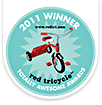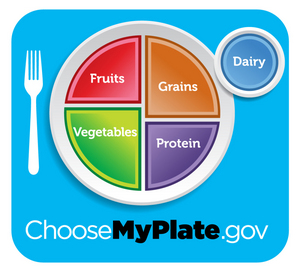USDA
Here’s what’s improved:
* More awareness of the appropriate and necessary quantities of fruits/veggies at every meal. Veggies should take up a decent amount of the plate, more than fruit.
* A visual for how to use the space on your plate to break up portions by type of food.
* Less focus and space for grains, as they are not as necessary as the other stuff on the plate. The old pyramid grossly overestimated the need for grains.
* Each meal (or plate) should have some protein and some carbs (although these need not be from grains or dairy, see below).
What’s missing:
* Fats: How in the world did the USDA NOT see all the research on healthy fats. There is a TON of it out there. We know it’s good for us. It keeps us healthy and alive longer as our systems work better and stronger. Additionally, it keeps ups fuller and satiated for longer. HEALTHY FAT DOES NOT MAKE YOU FAT. Extra calories and sugar make you fat. To leave fats off the plate suggests we’re still living in the fat free world that was 1995.
* Grains: Research has shown us that grains, especially given how processed most are, are not only an unnecessary part of most diets, but a harmful component to many diets. For many (possibly most) people wheat and gluten are highly allergenic foods that contribute to inflammation, disease, dysfunction and bloating (vain, maybe, but true!) Grains in their most basic forms (sprouted) can be tolerated my most folks, but this is not the form people tend to buy.
We have been lead to believe that we need grains in order to get carbs. Yes, you need carbs. Carbs are not bad. BUT, you can get these carbs from seeds, fruits and veggies without the harmful effects of breads, pasta, cereals, muffins. . . . AND, most people find if they switch from grains to more plate based choices they lose a ton of weight with little to no effort. Even endurance athletes have stepped away from the old model of pasta and pancake carb loading, as they recognize the benefit of getting their carbs from more wholesome and nutritious sources.
* Dairy: We do not need dairy at all, let alone at every meal. There relationship between the USDA and the Dairy Council is not only inappropriate, but also unethical. Dairy is another highly allergenic food group for many people. Additionally, if you cannot get your dairy in an organic form, it comes with all sorts of health risks given it’s laden with hormones and antibiotics. Research has shown over and over that our increase in dairy over the last few decades has not increased calcium absorption. It has not made our bones stronger or prevented osteoporosis. It has not made us healthier. In fact, with the huge increase in dairy consumption over the last three decades we are more obese and disease ridden than ever before. Thank you USDA and Dairy Council for taking such good care of us. This article illustrates this relationship: http://www.seriouseats.com/2010/11/how-the-usda-is-making-us-eat-more-cheese.html.
So, all in all, would I recommend the plate of the pyramid. Yes, but just barely. What should the ideal plate look like? A serving of lean protein with some fat, a big ole side of veggies, and a piece of fruit. On the side? Dump out that milk and drink some water for Pete’s sake.
Comments
Powered by Facebook Comments


